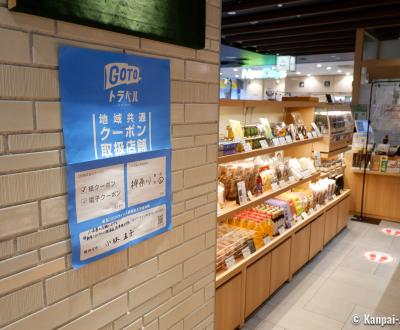Go To Travel Adds Further Delay to Foreign Tourists' Comeback to Japan
We mentioned several times "Go To Travel" in our articles related to Covid in Japan since spring 🌸 2020, but we never published a dedicated article on this campaign. As it is likely to resume in fall 2021, let’s have a look on what it entails.
What is "Go To Travel"?
Go To Travel is the name of a domestic tourism subsidy campaign intended to reviving Japan’s economy and especially help the tourism industry that was severely hit by the Coronavirus 🦠 pandemic.
It offers to cover 35 to 50% of travel expenses during a trip in Japan, including:
- Transportation,
- Accommodation,
- Food,
- Admission fees,
- Shopping.
The discount applies for a maximal daily amount of ¥10,000 (~US$63.83) for a day trip, or ¥20,000 (~US$127.67) for an overnight (or more) stay.
The prices displayed by most of the Japanese travel agencies (such as JTB or Rakuten) already include the discount, and it is even offered by websites such as Booking. A voucher can also be provided to use in a restaurant, a place to visit or in a shop to pay less.
Who can benefit from Go To Travel?
Contrary to a widespread belief, the campaign is not exclusive to Japanese nationals. However, it is practically the case: one must be resident of Japan to qualify for it.
As a matter of fact, it has been very difficult to get a Japanese visa since the end of 2020, and the "happy few" meet specific criteria. Beside Japanese nationals, almost only expatriates who were already living in Japan before Covid can therefore benefit from the campaign.
Naturally, overseas tourists who are admitted again in Japan in 2022 (after the borders’ reopening) are not in the scope of Go To Travel.
The total budget for the campaign initially amounted to 1,35 trillion Yens (~8.6 billions dollars) and on the first month of implementation in summer 2020, it benefited to 2 million Japanese.
When does the campaign take place?
In 2020, it was opened from July 22 to December 28, except in Tokyo where it only lasted from October 1 to December 18. It was intended to last about one year until June 2021, but the winter 3rd wave has disrupted the initial timeline.
In 2021, the resuming of Go To Travel was expected in autumn 🍁, but it was further delayed due to the succession of Covid waves and especially the 6th one (Omicron). The return of the subsidized campaign was, by the way, an election promise of the new Japanese Prime Minister, Fumio Kishida, under the condition of implementing a health passport. Tests have therefore been conducted during the second half of October (especially in Kyoto, Hokkaido and Fukuoka) to assess the limitation to vaccinated travelers in the new "Go To Travel" program.
A new stimulus package was in discussion in early November 2021 to relaunch the campaign.
According to the NHK, it was supposed to return in July 2022 in a less generous version. However, in early July, Prime Minister Kishida decided to postpone it again in view of the 7th Covid wave in Japan.
The Go To Travel campaign finally resumed on 2022, October 11 (on the day of the reopening to international tourism) and should have last until December 27, but its extension to early 2023 was announced one month before its previously expected ending.
Why is it controversial?
All along during its implementation in 2020, the subsidy campaign was accused of spreading Covid on the Japanese territory, as it incited people to travel throughout the archipelago and to eat indoors (without sanitary masks 😷 of course). A study by Kyoto University even confirmed this fact in January.
It is worth noting that, during 2021 state of emergency, that never really stopped during the first 9 months of the year, the government strongly recommended not to travel between prefectures.
"Go To Travel" was consequently considered an hypocrisy, as Covid was widely spread on the Japanese territory despite closed borders, and Japanese people could always travel overseas whereas Japan refused to accept foreign tourists on its territory.
In 2021, despite the 5th wave in summer, the most violent regarding the number of cases largely due to the Delta variant, the return of the domestic tourism incentive campaign was on the table as soon as things calm down. This stance is also understandable as the will to further delay the borders’ reopening to foreign tourists.
"Go To Travel" is certainly the key for an economic recovery of the tourism industry, but it is only the first step towards a gradual and orderly reopening:
- Business visas (Short stays first, long stays to be restored later)
- Students’ visas, Japan being the last country of the G7 to reinstate them, whereas many foreign students had to attend virtual classes during the night due to the time difference
- Working holiday visas
- Go To Travel, and,
- Lastly, tourists.
The objective of attracting 60 million visitors in Japan in 2030 was however never abandoned, despite the pandemic, and was reasserted in early October by the new Minister of Tourism Tetsuo Saito.






